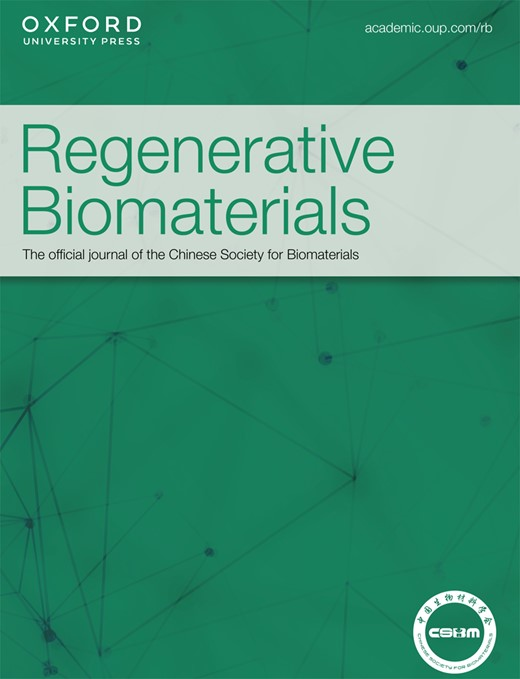电纺 PCL/明胶/熊果苷纳米纤维膜作为强效活性氧清除剂,可加速皮肤伤口愈合
IF 5.6
1区 医学
Q1 MATERIALS SCIENCE, BIOMATERIALS
引用次数: 0
摘要
皮肤伤口处存在过量活性氧(ROS)是影响伤口愈合的一个重要因素。清除 ROS 可调节 ROS 的微环境,对伤口愈合至关重要。本研究采用新型电纺 PCL/明胶/熊果苷(PCL/G/A)纳米纤维膜作为伤口敷料,以 PCL/明胶(PCL/G)为骨架,以植物提取的熊果苷(对苯二酚-β-D-吡喃葡萄糖苷,ARB)作为有效的抗氧化剂,清除 ROS 并抑制伤口细菌感染。ARB的负载增加了纳米纤维的机械强度,水蒸气透过率超过2500 g/(m2×24 h),水接触角减小,表明亲水性和透气性得到显著改善。药物释放和降解实验表明,纳米纤维膜可控制药物释放,并表现出良好的降解性。溶血实验表明 PCL/G/A 纳米纤维膜具有良好的生物相容性,DPPH 和 ABTS+自由基清除实验表明 PCL/G/A 能有效清除 ROS,体现了其抗氧化活性。此外,止血实验表明,PCL/G/A 在体外和体内都具有良好的止血效果。体内动物伤口闭合和组织学染色实验表明,PCL/G/A 增加了胶原沉积,促进了上皮组织再生,同时在体内表现出良好的生物相容性和无毒性。总之,我们成功制备了一种用于皮肤伤口愈合的多功能伤口敷料 PCL/G/A,并研究了它在伤口愈合中的潜在作用,这有利于植物药的临床转化应用。本文章由计算机程序翻译,如有差异,请以英文原文为准。
Electrospun PCL/gelatin/arbutin nanofiber membranes as potent reactive oxygen species scavengers to accelerate cutaneous wound healing
The presence of excessive reactive oxygen species (ROS) at a skin wound site is an important factor affecting wound healing. ROS scavenging, which regulates the ROS microenvironment, is essential for wound healing. In this study, we used novel electrospun PCL/gelatin/arbutin(PCL/G/A) nanofibrous membranes as wound dressings, with PCL/gelatin(PCL/G) as the backbone, and plant-derived arbutin (hydroquinone-β-D-glucopyranoside, ARB) as an effective antioxidant that scavenges ROS and inhibits bacterial infection in wounds. The loading of ARB increased the mechanical strength of the nanofibres, with a water vapour transmission rate of more than 2500 g/(m2×24 h), and the water contact angle decreased, indicating that hydrophilicity and air permeability were significantly improved. Drug release and degradation experiments showed that the nanofibre membrane controlled the drug release and exhibited favourable degradability. Haemolysis experiments showed that the PCL/G/A nanofibre membranes were biocompatible, and DPPH and ABTS+ radical scavenging experiments indicated that PCL/G/A could effectively scavenge ROS to reflect the antioxidant activity. In addition, haemostasis experiments showed that PCL/G/A had good haemostatic effects in vitro and in vivo. In vivo animal wound closure and histological staining experiments demonstrated that PCL/G/A increased collagen deposition and remodelled epithelial tissue regeneration while showing good in vivo biocompatibility and non-toxicity. In conclusion, we successfully prepared a multifunctional wound dressing, PCL/G/A, for skin wound healing and investigated its potential role in wound healing, which is beneficial for the clinical translational application of phytomedicines.
求助全文
通过发布文献求助,成功后即可免费获取论文全文。
去求助
来源期刊

Regenerative Biomaterials
Materials Science-Biomaterials
CiteScore
7.90
自引率
16.40%
发文量
92
审稿时长
10 weeks
期刊介绍:
Regenerative Biomaterials is an international, interdisciplinary, peer-reviewed journal publishing the latest advances in biomaterials and regenerative medicine. The journal provides a forum for the publication of original research papers, reviews, clinical case reports, and commentaries on the topics relevant to the development of advanced regenerative biomaterials concerning novel regenerative technologies and therapeutic approaches for the regeneration and repair of damaged tissues and organs. The interactions of biomaterials with cells and tissue, especially with stem cells, will be of particular focus.
 求助内容:
求助内容: 应助结果提醒方式:
应助结果提醒方式:


